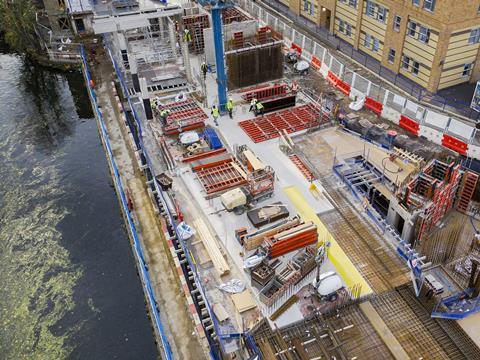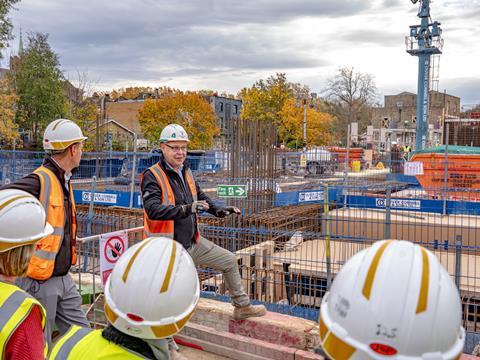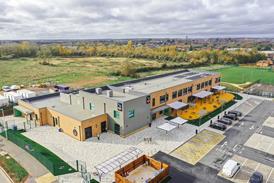Building was invited to attend Build UK’s Open Doors Preview event aimed at inspiring younger generations to pursue a career in construction by showcasing the progress being made at Queen Mary University of London’s East End campus

“We’re an industry of problem solvers,” declared Graham Dundas, Willmott Dixon’s chief executive officer at a preview event for Build UK’s Open Doors 2026.
The tier one contractor is currently redeveloping Queen Mary University of London’s new School of Business and Management, a challenging task given the central location and tight site space.
Willmott Dixon was picked for the £48.8m job in December 2024 and last week welcomed higher education students from Global Banking School to the site in Mile End, east London to give them behind-the-scenes insight into the project and the careers available in construction.
“All of us big employers in construction would cite finding suitably skilled staff as our number one challenge,” continued Dundas, highlighting the sector’s ageing workforce, which poses “a massive challenge for our industry, but also for the UK economy.”
Dundas himself joined Willmott Dixon as a trainee in the late 1990s, describing his journey so far as “fantastically rewarding and satisfying.”
Through Open Doors, an initiative which hosted more than 7,000 visitors across 260 events in its 2025 running period, Dundas hopes that more young people will “open their mind to a career in construction.”
The project
The creation of Queen Mary University of London’s new School of Business and Management will see an outdated student accommodation block replaced by a seven-storey building providing staff and students with new flexible spaces to learn and teach.
Craig Handley, a project manager at Willmott Dixon, described how enabling works had been undertaken by others prior to Willmott Dixon commencement for around 18 months before the contractor could get spades in the ground, stressing the importance and complexity of the logistics that went into creating the new substructure of the building.

After putting on high-vis jackets and hard hats, he invited the group of students to the site’s viewing area to observe the project’s current stage of basement excavation and installation of first-floor decking.
One building at the site – 357 Mile End Road – will be retained and refurbished, with remediation work currently underway. However, two and three-storey extensions will be gradually demolished, one of which could be seen standing behind the new-build, discoloured by old brick with its glassless windows boarded up.
With development still in the early stages, Willmott Dixon project manager Graham Thompson emphasised the essential role of temporary works, which are being designed and managed by the contractor to allow for the demolitions.
Thompson chatted about the project and shared his career journey with the aspiring construction industry members. Highlights have been becoming construction manager on a Passivhaus project and coming second place in a construction manager of the year competition.
“I’ve loved every single day of my job in construction,” he proclaimed without hesitation.
Challenges
However, large-scale projects, particularly in the capital, rarely make for smooth sailing.
With the site sitting within a university campus, cornered by Mile End Road to the south and Regent’s Canal to the east, Thompson explained that “you’ve got no room whatsoever” to store materials, which means receiving up to 50 delivery lorries a day.
There were further logistical challenges, such as the weight restrictions for vehicles passing above the eastbound tunnel of Mile End underground station. Handley explained that the “mobile crane that was required to erect the tower crane on site couldn’t actually come to site via Mile End Road, so we had to apply to bring the mobile crane in via an alternative route.” This required the suspension of 37 parking bays.
The team was also confronted by unexpected obstacles, including asbestos in the ground from the 1960s and 70s, which Thompson said “cost us time in our programme.” The area had also been “heavily bombed” during World War Two, which required the use of a UXO (unexploded ordenance) detection device to detect shapes that could be bombs and metal.

“Luckily none of them were,” said Thompson, although there were around eight obstructions.
If potential bombs and asbestos were not enough of a challenge, factor in the 10,000 university students milling around the campus, and you start to scratch the surface of what it takes to break ground at a development site.
“You’re always learning, everything’s so different, but the safety of the students is paramount,” Thompson said.
Handley highlighted the sector’s culture of collaboration, with the project demanding “lots of planning and engagement with the likes of the Canal & River Trust and Transport for London.”
After crossing a bridge and stepping down to canal level, Handley explained to the group, while dodging runners and cyclists, how the design for the new structure had to be assessed by the engineers at the Canal & River Trust to “make sure that our works won’t impact the structural integrity of that canal wall.”
Opening doors
For Amy Baber, assistant social value manager at Willmott Dixon, supporting routes into construction starts with spreading the word about the variety of positions available.
“I see a lot that students don’t have the education of the roles in construction. A lot of people think of the trade roles, which is brilliant, we need more people in trades, but they don’t necessarily know about the other roles in construction,” she explained.
“I love my job because I get to inspire people,” she added as the group wandered along the canal, with the engaged students asking questions at every opportunity.

One of these people is 18-year-old construction management student Nathan Arzah, who found the event “really informative.”
After ditching a career in professional football to follow a path where he could “make money for [himself]”, Barking-raised Arzah was inspired to pursue construction by a friend who was working in the industry. He did a stint as a labourer building flats and his dream is now to “climb the ranks” and manage the building of penthouses in London.
Build UK is supported by several industry partners to host Open Doors, including the Construction Industry Training Board (CITB), Construction Skills Certification Scheme and the Department for Work and Pensions.
For Chris Gingell, customer engagement manager at CITB, it all comes back to the problem-solving nature of the industry, with Willmott Dixon having to navigate issues that arise from “working next to water, the underground and the road closures.”
“The construction industry has a really good story to tell, but it’s up to all of us to inspire the construction workforce of tomorrow, today. There’s something for everyone, and it’s important we showcase the opportunities on offer to attract a diverse and skilled workforce,” he said.
Building is the media partner for Open Doors
Get involved with Open Doors 2026
Open Doors will take place from Monday 23 March to Saturday 28 March 2026. Companies interested in hosting events can find out more at: https://opendoors.construction/event-hosts/



























No comments yet